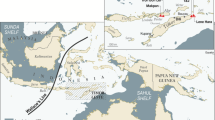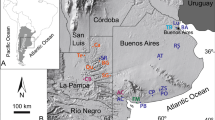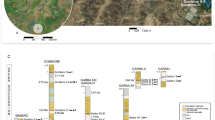Abstract
Sauropod dinosaurs were the largest vertebrates ever to walk the Earth, and as mega-herbivores they were important parts of terrestrial ecosystems. In the Late Jurassic-aged Morrison depositional basin of western North America, these animals occupied lowland river-floodplain settings characterized by a seasonally dry climate1,2. Massive herbivores with high nutritional and water needs could periodically experience nutritional and water stress under these conditions, and thus the common occurrence of sauropods in this basin has remained a paradox. Energetic arguments and mammalian analogues have been used to suggest that migration allowed sauropods access to food and water resources over a wide region or during times of drought or both3,4, but there has been no direct support for these hypotheses. Here we compare oxygen isotope ratios (δ18O) of tooth-enamel carbonate from the sauropod Camarasaurus with those of ancient soil, lake and wetland (that is, ‘authigenic’) carbonates that formed in lowland settings. We demonstrate that certain populations of these animals did in fact undertake seasonal migrations of several hundred kilometres from lowland to upland environments. This ability to describe patterns of sauropod movement will help to elucidate the role that migration played in the ecology and evolution of gigantism of these and associated dinosaurs.
This is a preview of subscription content, access via your institution
Access options
Subscribe to this journal
Receive 51 print issues and online access
$199.00 per year
only $3.90 per issue
Buy this article
- Purchase on Springer Link
- Instant access to full article PDF
Prices may be subject to local taxes which are calculated during checkout


Similar content being viewed by others
References
Parrish, J., Peterson, F. & Turner, C. E. Jurassic ‘savannah’ – plant taphonomy and climate of the Morrison Formation (Upper Jurassic, Western USA). Sedim. Geol. 167, 139–164 (2004)
Turner, C. E. & Peterson, F. Reconstruction of the Upper Jurassic Morrison Formation extinct ecosystem–a synthesis. Sedim. Geol. 167, 309–355 (2004)
Engelmann, G. F., Chure, D. J. & Fiorillo, A. R. The implications of a dry climate for the paleoecology of the fauna of the Upper Jurassic Morrison Formation. Sedim. Geol. 167, 297–308 (2004)
Dodson, P., Behrensmeyer, A. K., Bakker, R. T. & McIntosh, J. S. Taphonomy and paleoecology of the dinosaur beds of the Jurassic Morrison Formation. Paleobiology 6, 208–232 (1980)
Gat, J. R. Oxygen and hydrogen isotopes in the hydrologic cycle. Annu. Rev. Earth Planet. Sci. 24, 225–262 (1996)
Bowen, G. Isoscapes: spatial pattern in isotopic biogeochemistry. Annu. Rev. Earth Planet. Sci. 38, 161–187 (2010)
Kohn, M. J. & Cerling, T. E. Stable isotope compositions of biological apatite. Rev. Mineral. Geochem. 48, 455–488 (2002)
Amiot, R. et al. Latitudinal temperature gradient during the Cretaceous Upper Campanian–Middle Maastrichtian: δ18O record of continental vertebrates. Earth Planet. Sci. Lett. 226, 255–272 (2004)
Dunegan, S. & Turner, C. Regional paleohydrologic and paleoclimatic settings of wetland/lacustrine depositional systems in the Morrison Formation (Upper Jurassic), Western Interior, USA. Sedim. Geol. 167, 269–298 (2004)
Lovelace, D. An Upper Jurassic Morrison Formation fire-induced debris flow: taphonomy and paleoenvironment of a sauropod (Sauropoda: Supersaurus vivianae) locality, east–central Wyoming. Bull. New Mexico Mus. Nat. Hist. 36, 47–56 (2006)
Jennings, D. S. & Lovelace, D. M. Driese, S.G. Differentiating paleowetland subenvironments using a multi-disciplinary approach: an example from the Morrison Formation, South Central Wyoming, USA. Sedim. Geol. 10.1016/j.sedgeo.2011.03.005. (2011)
Fallin, M. J. Carbon Isotope Stratigraphy of the Morrison and Cloverly Formations and Assessment of Vertical Color Change in the Morrison Formation, Coyote Basin, Wyoming. Master’s thesis, Univ. Colorado, Boulder. (2005)
Sellwood, B. W. & Valdes, P. J. Jurassic climates. Proc. Geol. Assoc. 119, 5–17 (2008)
Erickson, G. M. Incremental lines of von Ebner and the assessment of tooth replacement rates using growth line counts. Proc. Natl Acad. Sci. USA 93, 14623–14627 (1996)
Fricke, H. C. & O’Neil, J. R. Inter-and intra-tooth variation in the oxygen isotope composition of mammalian tooth enamel phosphate: implications for palaeoclimatological and palaeobiological research. Palaeogeogr. Palaeoclimatol. Palaeoecol. 126, 91–99 (1996)
Kohn, M. J., Schoeninger, M. J. & Valley, J. W. Variability in oxygen compositions of herbivore teeth: reflections of seasonality or developmental physiology? Chem. Geol. 152, 97–112 (1998)
Stanton-Thomas, K. J. & Carlson, S. J. Microscale δ18O and δ13C isotopic analysis of an ontogenetic series of the hadrosaurid dinosaur Edmontosaurus: implications for physiology and ecology. Palaeogeogr. Palaeoclimatol. Palaeoecol. 206, 257–287 (2004)
Podlesak, D. W. et al. Turnover of oxygen and hydrogen isotopes in the body water, CO2, hair, and enamel of a small mammal. Geochim. Cosmochim. Acta 72, 19–35 (2008)
Rees, P. M., Ziegler, A. M. & Valdes, P. J. in Warm Climates in Earth History (eds Huber, B. T. et al.) 297–318 (Cambridge Univ. Press, 2003)
Acknowledgements
We thank S. Hartman, D. Lovelace and D. Chure for providing context and fossil specimens. The research was funded in part by National Science Foundation EAR-0319041 and Colorado College. We thank G. Olack and A. Colman for the phosphate oxygen isotope analyses, supported by National Science Foundation Major Research Instrumentation award EAR 0923831.
Author information
Authors and Affiliations
Contributions
J.H. analysed samples and interpreted data from Dinosaur National Monument; M.E.H. analysed samples, interpreted data from Thermopolis and did the statistical analysis. H.C.F. designed the study, aided in data interpretation and wrote the manuscript.
Corresponding author
Ethics declarations
Competing interests
The authors declare no competing financial interests.
Supplementary information
Supplementary Information
The file contains Supplementary Methods, Supplementary References, Supplementary Figure 1 with a legend and Supplementary Tables 1-4. (PDF 1271 kb)
PowerPoint slides
Rights and permissions
About this article
Cite this article
Fricke, H., Hencecroth, J. & Hoerner, M. Lowland–upland migration of sauropod dinosaurs during the Late Jurassic epoch. Nature 480, 513–515 (2011). https://doi.org/10.1038/nature10570
Received:
Accepted:
Published:
Issue Date:
DOI: https://doi.org/10.1038/nature10570
This article is cited by
-
Descendants of the Jurassic turiasaurs from Iberia found refuge in the Early Cretaceous of western USA
Scientific Reports (2017)
-
Dinosaur teeth from the Jurassic Qigu and Shishugou Formations of the Junggar Basin (Xinjiang/China) and their paleoecologic implications
Paläontologische Zeitschrift (2015)
-
Tooth chemistry reveals sauropod sojourns
Nature (2011)
Comments
By submitting a comment you agree to abide by our Terms and Community Guidelines. If you find something abusive or that does not comply with our terms or guidelines please flag it as inappropriate.



